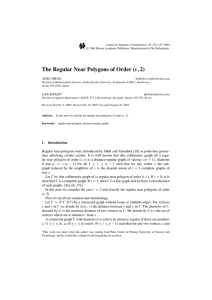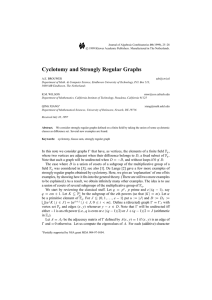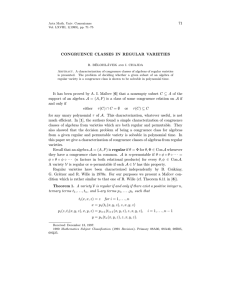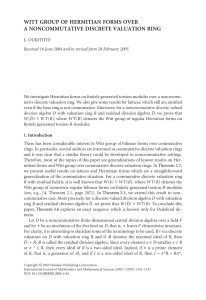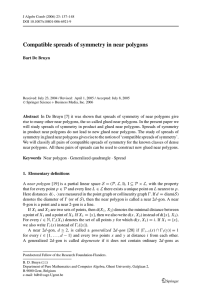A Higman-Haemers Inequality for Thick Regular Near Polygons
advertisement
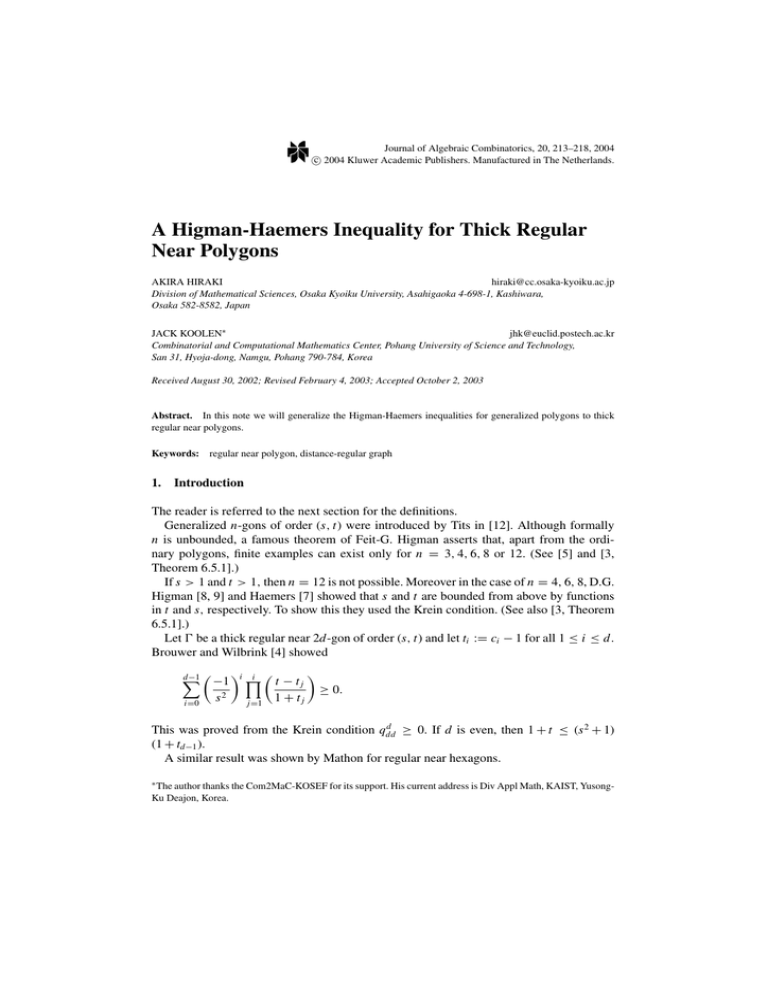
Journal of Algebraic Combinatorics, 20, 213–218, 2004
c 2004 Kluwer Academic Publishers. Manufactured in The Netherlands.
A Higman-Haemers Inequality for Thick Regular
Near Polygons
AKIRA HIRAKI
hiraki@cc.osaka-kyoiku.ac.jp
Division of Mathematical Sciences, Osaka Kyoiku University, Asahigaoka 4-698-1, Kashiwara,
Osaka 582-8582, Japan
JACK KOOLEN∗
jhk@euclid.postech.ac.kr
Combinatorial and Computational Mathematics Center, Pohang University of Science and Technology,
San 31, Hyoja-dong, Namgu, Pohang 790-784, Korea
Received August 30, 2002; Revised February 4, 2003; Accepted October 2, 2003
Abstract. In this note we will generalize the Higman-Haemers inequalities for generalized polygons to thick
regular near polygons.
Keywords: regular near polygon, distance-regular graph
1.
Introduction
The reader is referred to the next section for the definitions.
Generalized n-gons of order (s, t) were introduced by Tits in [12]. Although formally
n is unbounded, a famous theorem of Feit-G. Higman asserts that, apart from the ordinary polygons, finite examples can exist only for n = 3, 4, 6, 8 or 12. (See [5] and [3,
Theorem 6.5.1].)
If s > 1 and t > 1, then n = 12 is not possible. Moreover in the case of n = 4, 6, 8, D.G.
Higman [8, 9] and Haemers [7] showed that s and t are bounded from above by functions
in t and s, respectively. To show this they used the Krein condition. (See also [3, Theorem
6.5.1].)
Let be a thick regular near 2d-gon of order (s, t) and let ti := ci − 1 for all 1 ≤ i ≤ d.
Brouwer and Wilbrink [4] showed
i d−1 t − tj
−1 i ≥ 0.
s2
1 + tj
i=0
j=1
d
This was proved from the Krein condition qdd
≥ 0. If d is even, then 1 + t ≤ (s 2 + 1)
(1 + td−1 ).
A similar result was shown by Mathon for regular near hexagons.
∗ The author thanks the Com2MaC-KOSEF for its support. His current address is Div Appl Math, KAIST, YusongKu Deajon, Korea.
214
HIRAKI AND KOOLEN
In this note we are going to show that for thick regular near 2d-gons of order (s, t), t is
bounded from above by a function of s and the diameter d.
In particular, we show the following results. We will only use the multiplicity of the
smallest eigenvalue to show those results.
Theorem 1 Let be a distance-regular graph of order (s, t) with s > 1. Let d be the
diameter of , r := max{i | (ci , ai , bi ) = (c1 , a1 , b1 )} and ρ := dr . Suppose −t − 1 is an
eigenvalue of . Then t < s 4ρ−1 .
Corollary 2 Let be a thick regular near 2d-gon of order (s, t). Let r := max{i |
(ci , ai , bi ) = (c1 , a1 , b1 )} and ρ := dr . Then the following hold.
(1) t < s 4ρ−1 .
(2) If r ∈ {1, 2, 3, 5}, then t < s 7 .
A generalized 2d-gon of order (s, t) is a regular near 2d-gon of order (s, t) with d = r +1.
It is known that if a generalized 2d-gon of order (s, t) exists, then there exists a generalized
2d-gon of order (t, s) which is known as dual. So as a consequence of this corollary we
will show that for generalized 2d-gons we can bound s and t by functions in t and s,
respectively.
Let be a generalized 2d-gon of order (s, t). Then the following hold.
3d+1
(1) If s > 1, then t < s d−1 .
3d+1
(2) If t > 1, then s < t d−1 .
The bound given by Higman [8, 9] and Haemers [7] can be proved without using the
Krein condition although the bound proved here is a bit weaker.
Let us consider another consequence of Corollary 2. Suppose it is true that for given
s and t there are only finitely many regular near 2d-gons of order (s, t). Then for given
s > 1 there are only finitely many regular near 2d-gons of order (s , t ) with r = max{i |
(ci , ai , bi ) = (c1 , a1 , b1 )} ≥ 6. Furthermore, for a regular near 2d-gons of order (s , t ) the
diameter d is bounded by a function in s .
2.
Definitions
Let = (V , E) be a connected graph without loops or multiple edges. For vertices x
and y in we denote by ∂ (x, y) the distance between x and y in . For a vertex x in and a set L of vertices we define ∂ (x, L) := min{ ∂ (x, z) | z ∈ L }.
The diameter of , denoted by d, is the maximal distance of two vertices in . We denote
by i (x) the set of vertices which are at distance i from x.
A connected graph with diameter d is called distance-regular if there are numbers
ci (1 ≤ i ≤ d),
ai (0 ≤ i ≤ d)
and
bi (0 ≤ i ≤ d − 1)
215
HIGMAN-HAEMERS INEQUALITY
such that for any two vertices x and y in at distance i the sets
i−1 (x) ∩ 1 (y),
i (x) ∩ 1 (y)
and
i+1 (x) ∩ 1 (y)
have cardinalities ci , ai and bi , respectively. Then is regular with valency k := b0 .
Let be a distance-regular graph with diameter d. The array
∗
ι() = a0
b0
a1
· · · ci
· · · ai
. . . cd−1
. . . ad−1
b1
···
. . . bd−1
c1
bi
cd
ad
∗
is called the intersection array of . Define r = r () := max{i | (ci , ai , bi ) = (c1 , a1 , b1 )}.
The numerical girth of is 2r + 2 if cr +1 = 1 and 2r + 3 if cr +1 = 1.
By an eigenvalue of we will mean an eigenvalue of its adjacency matrix A. Its multiplicity is its multiplicity as eigenvalue of A. Define the polynomials u i (x) by
u 0 (x) := 1,
u 1 (x) := x/k,
and
ci u i−1 (x) + ai u i (x) + bi u i+1 (x) = xu i (x),
i = 1, 2, . . . , d − 1.
Let ki := |i (x)| for all 0 ≤ i ≤ d which does not depend on the choice of x.
Let θ be an eigenvalue of with multiplicity m. It is well-known that
m = d
|V |
i=0 ki u i (θ )
2
.
For more information on distance-regular graphs we would like to refer to the books
[1–3] and [6].
A graph is said to be of order (s, t) if 1 (x) is a disjoint union of t + 1 cliques of size s
for every vertex x in . In this case, is a regular graph of valency k = s(t + 1) and every
edge lies on a clique of size s + 1. A clique of size s + 1 is called a singular line of .
A graph is called (the collinearity graph of ) a regular near 2d-gon of order (s, t)
if it is a distance-regular graph of order (s, t) with diameter d and ai = ci (s − 1) for all
1 ≤ i ≤ d.
A regular near 2d-gon is called thick if s > 1.
A generalized 2d-gon of order (s, t) is a regular near 2d-gon of order (s, t) with d = r +1.
More information on regular near 2d-gons and generalized 2d-gons will be found in [3,
Sections 6.4–6.6].
3.
Proof of the theorem
In this section we prove our theorem. First we recall the following result.
216
HIRAKI AND KOOLEN
Proposition 3 [11, Proposition 3.3] Let be a distance-regular graph with valency k,
numerical girth g such that each edge lies in an (a1 + 2)-clique. Let h be a positive integer.
Suppose θ = − a1k+1 be an eigenvalue of with multiplicity m. Then the following hold.
(1) If g ≥ 4h, then
m ≥1+
ka1 b1h − 1
.
a 1 + 1 b1 − 1
(2) If g ≥ 4h + 2, then
m≥
1
a1 (a1 + 2) b1h+1 − 1
+
.
a1 + 1
a1 + 1
b1 − 1
Lemma 4 Let be a distance-regular graph of order (s, t) with diameter d. Suppose
−t − 1 is an eigenvalue of with multiplicity m. Then for any integer i with 0 ≤ i ≤ d,
the following hold.
(1) Let C be a clique of size s + 1 and x ∈ V with ∂ (x, C) = i. Then
αi := |{z ∈ C | ∂ (x, z) = i}|
does not depend on the choice of C and x. Furthermore, ∂ (x, C) ≤ d − 1 for any
vertex x in .
(2) There exists an integer γi such that ci = γi αi−1 and bi = (t + 1 − γi )(s + 1 − αi ).
(3) Let u j := u j (−t − 1) for all 0 ≤ j ≤ d. Then for all 1 ≤ j ≤ d we have
uj =
−α j−1
u j−1 .
s + 1 − α j−1
In particular,
u i2
2i
1
≥
.
s
(4) m ≤ s 2d with equality if and only if s = 1.
Proof: (1) See [4, Lemma 13.7.2].
(2) Let x and y be vertices in at distance i. Let γi be the number of singular lines
through y at distance i − 1 from x. Each such clique has αi−1 vertices which are at distance
i − 1 from x. Hence we have ci = γi αi−1 . There are t + 1 − γi singular lines through y at
distance i from x. Each such clique has s + 1 − αi vertices which are at distance i + 1 from
x. Then we have bi = (t + 1 − γi )(s + 1 − αi ).
(3) We prove the first assertion by induction on j. The case j = 1 is true since u 0 =
1, u 1 = − 1s and α0 = 1.
HIGMAN-HAEMERS INEQUALITY
217
Assume 1 ≤ j ≤ d − 1 and α j−1 u j−1 = −(s + 1 − α j−1 )u j . Then we have
b j u j+1 = (−t − 1 − a j )u j − c j u j−1
= {−t − 1 − (t + 1)s + c j + b j }u j + γ j (s + 1 − α j−1 )u j
= {−(t + 1)(s + 1) + γ j α j−1 + (t + 1 − γ j )(s + 1 − α j )
+ γ j (s + 1 − α j−1 )}u j
= −(t + 1 − γ j )α j u j
from (2). The first assertion is proved. Since
−α j−1
s + 1 − α j−1
2
≥
2
1
,
s
the second assertion follows from the first assertion.
(4) We have
M :=
d
i=0
ki u i2
2i 2d d
d
1
1
|V |
≥
ki
≥
ki = 2d .
s
s
s
i=0
i=0
Hence
m=
|V |
≤ s 2d .
M
Proof of Theorem 1: We remark that a1 = s − 1 and b1 = st. Let g be the numerical
girth of .
First we assume r is odd with r = 2h − 1. Then g ≥ 2r + 2 = 4h and
m>
ka1 h−1
= (t + 1)(s − 1)(st)h−1 > s h−1 t h
b
a1 + 1 1
from Proposition 3 (1). It follows, by Lemma 4 (4), that
s (4h−2)ρ = s 2d ≥ m > s h−1 t h .
The desired result is proved.
Second we assume r is even with r = 2h. Then g ≥ 2r + 2 = 4h + 2 and m > b1h from
Proposition 3 (2). Hence we have
s 4hρ = s 2d ≥ m > (st)h .
The desired result is proved.
218
HIRAKI AND KOOLEN
In [10], we have shown the following result.
Proposition 5 Let be a thick regular near 2d-gon with r = r (). If 2r + 1 ≤ d then
for any integer q with r + 1 ≤ q ≤ d − r there exists a regular near 2q-gon as a strongly
closed subgraph in . In particular, r ∈ {1, 2, 3, 5}.
Proof of Corollary 2: It is known that a regular near 2d-gon of order (s, t) has an
eigenvalue −t − 1. Moreover if r ∈ {1, 2, 3, 5}, then d ≤ 2r from Proposition 5. Therefore
the corollary is a direct consequence of Theorem 1.
References
1. E. Bannai and T. Ito, Algebraic Combinatorics I: Association Schemes, Benjamin-Cummings Lecture Note
Ser. 58, Benjamin/Cummings Publ. Co., London, 1984.
2. N.L. Biggs, Algebraic Graph Theory, Cambridge Tracts in Math. 67, Cambridge Univ. Press, 1974.
3. A.E. Brouwer, A.M. Cohen, and A. Neumaier, Distance-Regular Graphs, Springer, Heidelberg, 1989.
4. A.E. Brouwer and H.A. Wilbrink, “The structure of near polygons with quads,” Geom. Dedicata 14 (1983)
145–176.
5. W. Feit and G. Higman, “The non-existence of certain generalized polygons,” J. Algebra 1 (1964), 114–131.
6. C.D. Godsil, Algebraic Combinatorics, Chapman and Hall, New York, 1993.
7. W.H. Haemers and C. Roos, “An inequality for generalized hexagons,” Geom. Dedicata 10 (1981), 219–222.
8. D.G. Higman, “Partial geometries generalized quadrangles and strongly regular graphs,” pp. 263–293 in Atti
del Convegno di Geometria, Combinatoria e sue Applicazioni (Univ. degli Studi di Perugia, Perugia, 1970),
Perugia 1971.
9. D.G. Higman, “Invariant relations, coherent configurations and generalized polygons,” pp. 27–43 in Combinatorics, Math Centre Tracts 57, Amsterdam, 1974.
10. A. Hiraki, “Strongly closed subgraphs in a regular thick near polygons,” European J. Combin. 20 (1999),
789–796.
11. A. Hiraki and J.H. Koolen, “An improvement of the Godsil bound,” Ann. of Combin. 6 (2002), 33–44.
12. J. Tits, “Sur la trialité et certains groups qui s’en déduisent,” Publ. Math. I.H.E.S. 2 (1959), 14–60.
